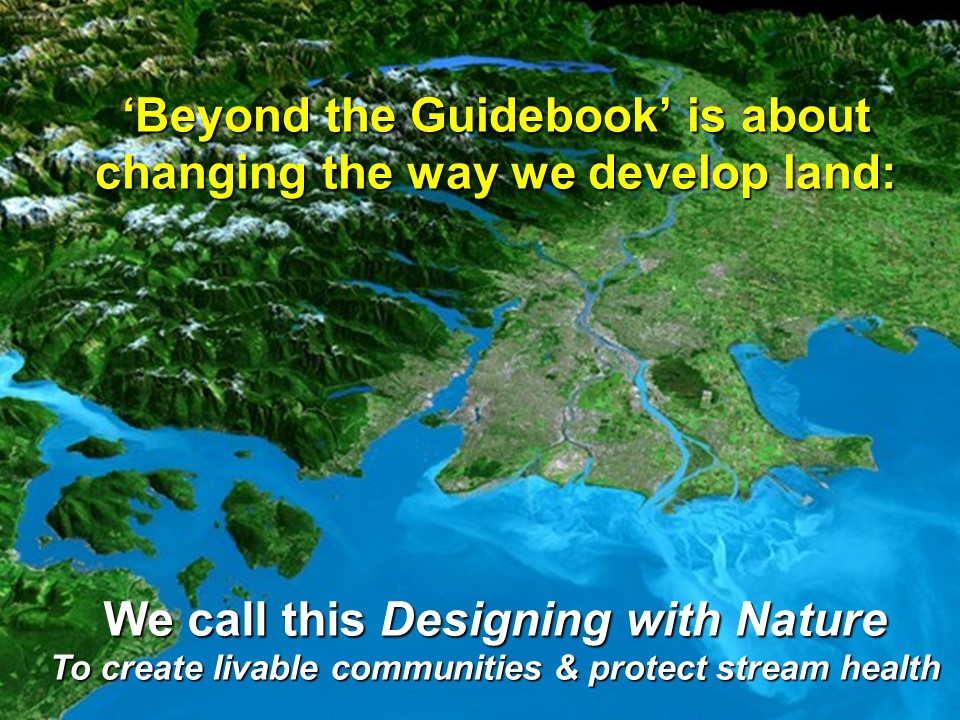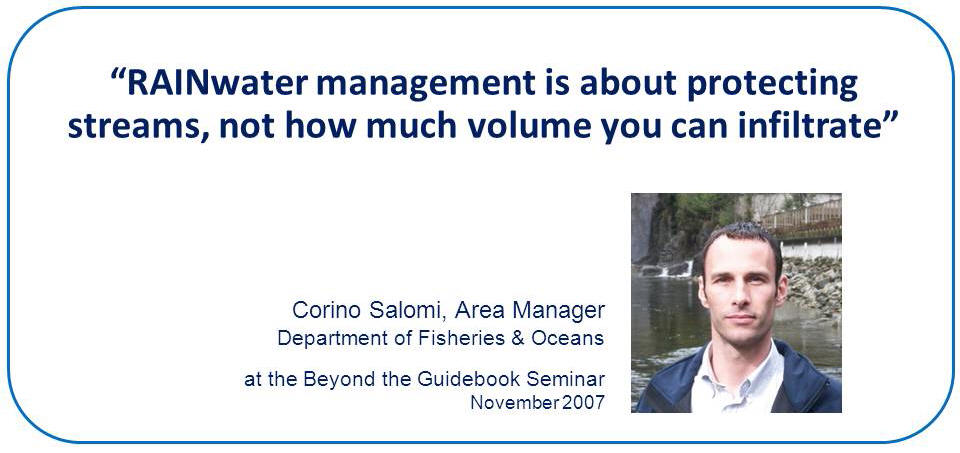AT 2007 BEYOND THE GUIDEBOOK SEMINAR – "Rainwater management is about protecting stream health, not how much volume you can infiltrate," stated DFO's Corino Salomi
Note to Reader:
The Beyond the Guidebook Initiative is aligned with the Urban Stormwater Guidelines and Best Management Practices for Protection of Fish and Fish Habitat, originally released in 2000 as a Discussion Paper by the Department of Fisheries and Oceans (DFO) to provide local governments with interim guidance as to future direction.
In November 2007, the Beyond the Guidebook Seminar provided DFO with a platform to set the record straight with respect to use (and misapplication by some consultants and others) of the 4-page so-called “DFO Guidelines”.
From Guidelines to Tools
Under the umbrella of the Water Sustainability Action Plan for British Columbia, the Green Infrastructure Partnership (GIP) rolled out Beyond the Guidebook at a seminar hosted by the Association of Professional Engineers and Geoscientists in November 2007.
DFO Expectation – Do What is Right for Environment
Because DFO was on the GIP Steering Committee, the Beyond the Guidebook Seminar provided a forum for Corino Salomi of DFO (Lower Fraser Valley) to inform local government and land use practitioners regarding the emerging policy framework and senior government expectations for applying a Beyond the Guidebook approach to land development and watershed management.
To set the scene for what he wished to accomplish via his presentation, Corino provided his audience with this context:
“My Beyond the Guidebook presentation is not about DFO telling you what to do. Rather, my take-away message is that the Beyond the Guidebook philosophy is about establishing what we are able to achieve through rainfall runoff capture at the source, where rain lands. Furthermore, embracing the Beyond the Guidebook philosophy means we will collaborate to improve land development practices because we share an ethic to do what is right for the environment.”
DFO Policy for Management of Fish Habitat is embodied in Beyond the Guidebook
“We are moving from guidelines to tools”, Corino emphasized when introducing the road-map for his presentation, which was structured in three parts:
- an overview of fish habitat management policy and legislation;
- the history of guidelines in British Columbia; and
- a federal perspective on Beyond the Guidebook.
Corino observed that the Policy for the Management of Fish Habitat (1986) can be viewed as providing an over-arching framework for the pragmatic approach embodied in Beyond the Guidebook 2007. He explained that the policy was implemented to support the habitat provisions of the Fisheries Act, promote sustainable development and help counter the negative impacts that development activities can have on fish habitat.
“Most people are familiar with the conservation goal which requires that the current productive capacity of existing habitats is maintained by applying the no net loss guiding principle”, observed Corino, “Yet there is much, much more to the policy. It addresses integrated resource planning, for example, and also speaks to the themes covered in the program for this Beyond the Guidebook Seminar.”
To Learn More:
Download a PDF copy of Moving from Stormwater Management to RAINwater Management: A DFO Perspective.
Why Beyond the Guidebook –
Initiate a Course Correction
“It helps to look back to understand how we got to here. In November 2000, DFO released the 4-page Urban Stormwater Guidelines and Best Management Practices for Protection of Fish and Fish Habitat, Draft Discussion Document. That document set a direction.”
“By 2007, however, we had concerns about how the document was being interpreted and applied. The Beyond the Guidebook initiative has initiated a course correction that will help local governments and the development community establish what level of rainwater runoff volume reduction makes sense at the site, catchment and watershed scales.”
“The objective is protect stream health, which is broader than how much volume one can infiltrate on a particular development.”
Runoff-Based Approach
Beyond the Guidebook 2007 describes a runoff-based approach to drainage modelling. Furthermore, it connects the dots between source control evaluation and stream health assessment. In a nutshell, it means this is ‘where science meets analysis’ because runoff volume management is directly linked to stream erosion and water quality.
The runoff-based approach underpins the evolving Water Balance Methodology. This will allow practitioners to assess both site-level rainwater management measures AND flood relief projects so that they can develop a watershed approach that addresses stream protection and/or restoration. In the process, practitioners will view the watershed and its streams from a much more holistic perspective.
Move from STORMwater to RAINwater Management
Corino Salomi described the Beyond the Guidebook as a ‘must read’ because of the way it provides a synopsis of what is most relevant and useful. “We now have the tools and the experience to design with nature and move from stormwater management to  RAINwater management”, he stated in his closing remarks.
RAINwater management”, he stated in his closing remarks.
“While we need to have volume reduction targets, at the end of the day it is how effectively we apply the suite of available rainwater management tools that will ultimately determine whether we will succeed in protecting stream health at a watershed scale,” concluded Corino.
To Learn More:
Download Moving from Stormwater Management to RAINwater Management: A Federal Fisheries Perspective to read the complete story about the presentation by Corino Salomi.





